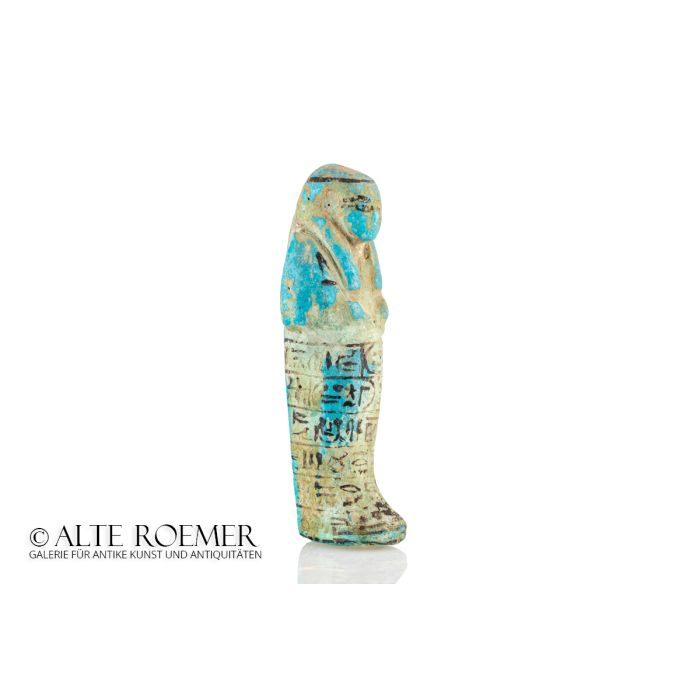Funerary statuette for Princess Henuttawy
Price: on request
Sold
Object number
AR3170
| Object: |
Funerary statuette for Princess Henuttawy
|
| Material: |
Turquoise faience with black paint.
|
| Period: |
Approx. 980 BC to 930 BC. End of the 21st to beginning of the 22nd dynasty. Third Intermediate Period of Ancient Egypt. |
| Description: |
Egyptian funerary statuette with a mummy shaped body. Details are summarily modelled, arms are crossed in front of the chest. Further details are painted in black. The ushabti wears a tripartite wig secured by a fillet with rear ties (seshed), agricultural implement in each hand, a seed basket on the back. Six lines of hieroglyphs cover the front and sides. They translate to:
The illuminated one, the Osiris, divine adoratice, Henuttawy, she speaks, O these shabtis, |
| Dimensions: |
156mm height.
|
| Condition: |
Almost perfect condition. Merely a small chip on the faience surface under the foot. The original black painting is also clearly visible. Interesting two-tone patina.
|
| Provenance: |
Acquired by us on the UK art market in 2021. Previously in a British family collection. Added to the collection in 1952 from Spink & Son, London. It is passed down that the piece was acquired in 1910 by the bishop of Cairo, who was active as an hobby Egyptologist. The shabtis of Henuttawy come from a 22nd dynasty tomb within the Ramesseum, West of Thebes (cf. Aubert, pp. 146 and 165, pl. 31, nos. 68-69). This famous memorial temple for Pharaoh Ramesses II "the Great" was excavated in the 19th century to fill local and international museums and collections. The first Henuttawy shabtis appeared in museum collections since 1845. They must have been excavated between approx. 1840 and 1845. Are the shabtis of Henuttawy from the Ramesseum or Deir el-Bahari? Some are attributed to the Royal Cache, tomb TT320 (previously known as DB320), a Theban cachette of the royal mummies also known as Deir el-Bahari. And this attribution is still passed down by museums and art dealers. However, researchers these days are sure that the figurines are from the Ramesseum. The old confusion stems from different persons of the name Henuttawy living during the 21st dynasty. The details are very nicely explained by Faye Kolloniatis for the Henuttawy shabti in the Norwich Castle Museum (see literature reference below). |
| References: |
Cf. Schneider, Shabtis, p. 119, no. 4.3.0.8. Cf. G. Janes, Shabtis, A Private View, no.58. Other shabtis of this owner are found in museum and private collections around the world, which they entered often around 1900 while the earliest date is 1845. Here are some examples from museums: National Museum of Ireland, Dublin, 1892:22/229 (year of acquisition 1892) and E72:81. Egyptian Collection at Norwich Castle Museum, acc. no. 1921.37.101. Accessioned in 1921. British Museum London, museum no. EA15763, reg. no. 1885,0723.62. Purchased in 1885. San Antonio Musuem of Art, obj. no. 86.138.160. Previously purchased by the Stark family, Orange, Texas, between 1927 and 1929. And further examples on the art market see: Hixenbaugh, Servants for Eternity, Egyptian Ushabtis (2016), pp. 16f. Phoenix Ancient Art, USA, serial no. 28491 (offered for 35,000 USD in 2022). Christie's London, auction 24 July 1994, Antiquities, lot 89. |
| Literature: |
For the discussion of the tomb of Henuttawy see Faye Kolloniatis, The Egyptian Collection at Norwich Castle Museum (Oxbow, 2019), cat. no. 16. For a well-known excavation report in the Ramesseum see J. E. Quibell in The Ramesseum, in Egyptian Research Account 1896 (London, 1898). Most finds are described summarily and thus can't be identified in retrospect. But it's still an interesting read to get a glimpse of how archaeological excavations were done back in those days. A good introduction and overview on Egyptian shabtis in just one volume is given by Glenn Janes in Shabtis: A Private View - Ancient Egyptian Funerary Statuettes in European Private Collections. And a relatively recent read about Egyptian royals is by Aidan Dodson and Dyan Hilton, The Complete Royal Families of Ancient Egypt (2004), p. 205 for the family of Henuttawy. |
| Authenticity: |
We unconditionally guarantee the authenticity of every artefact, all items are subject to our lifetime return policy on authenticity.
|


